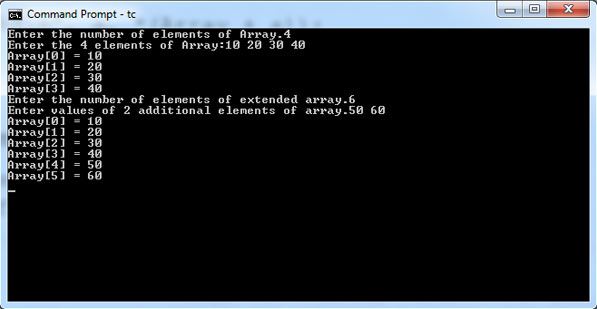The function realloc () is used to resize the memory allocated earlier by function malloc () to a new size given by the second parameter of the function. The function realloc(ptr,n) uses two arguments.the first argument ptr is a pointer to a block of memory for which the size is to be altered. The second argument n specifies the new size. The size may be increased or decreased.
If n is greater than the old size and if sufficient space is not available subsequent to the old region, the function realloc( ) may create a new region and all the old data are moved to the new region.
Illustrates malloc() and realloc ().
#include <stdio.h>
#include<stdlib.h>
int main ()
{
int a= 0, n, m, i, j,k =0;
int* Array;
clrscr();
printf("Enter the number of elements of Array.");
scanf("%d", &n );
Array= (int*) malloc( n* sizeof(int) );
if( Array== NULL)
{
printf("Error. Out of memory.\n");
exit(0);
}
printf("Enter the %d elements of Array:", n);
for ( i =0; i<n; i++)
scanf("%d",&Array[i]);
for( j =0;j<n; j++)
printf("Array[%d] = %d\n", j, *(Array+j));
printf("Enter the number of elements of extended array.");
scanf("%d", &m);
Array= realloc(Array, m);
if( Array== NULL)
{
printf("realloc has failed.\n");
exit(0);
}
printf("Enter values of %d additional elements of array.", m-n);
for (k= n ; k<m; k++)
scanf("%d", &Array[k]);
for( a =0;a<m; a++)
printf("Array[%d] = %d\n", a, *(Array+ a));
return 0;
}

 Dinesh Thakur holds an B.C.A, MCDBA, MCSD certifications. Dinesh authors the hugely popular
Dinesh Thakur holds an B.C.A, MCDBA, MCSD certifications. Dinesh authors the hugely popular